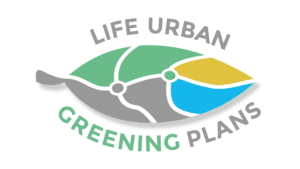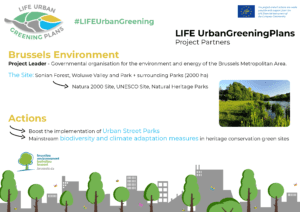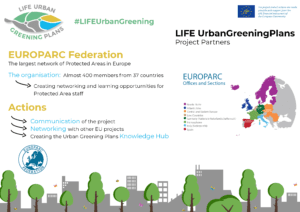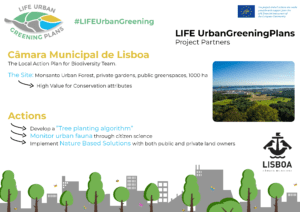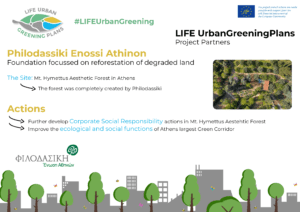Woluwe Boulevard, Brussels
EUROPARC was part of the two year LIFE UrbanGreeningPlans project that worked on greening urban areas through implementing better management practices and Nature-based Solutions.
Designing innovative mechanisms to plan, implement, strengthen and manage green infrastructures in (peri-)urban areas
- Duration 2021 – 2023
The EU Biodiversity Strategy 2030 calls upon cities with over 20.000 inhabitants to create Urban Greening Plans by the end of 2021. These plans aim to bring nature back into cities to support biodiversity and mitigate climate change. To help cities achieve this ambitious goal, the European Commission will create a EU Urban Greening Platform, under a new ‘Green City Accord’ with cities and mayors. This was the framework of the LIFE UrbanGreeningPlans project.
One of the main outputs, was the special Knowledge Hub, which you can find here:
To the Greening Plans Knowledge Hub!
There are a number of challenges for cities that want to implement Urban Greening Plans. The project worked on tackling the main 4:
- Lack of knowledge and expertise among policy makers and city officers on how to implement and maintain Green Infrastructures
- Bad connectivity and accessibility of peri-urban green spaces due to growing cities and spatial pressure, as well as due to the historically poor urban planning of peri-urban areas
- Poor cooperation across different sectors within a municipality and/or different municipalities. Co operations are needed because of the multi-scalar and multi-functional nature of Green Infrastructure
- Lack of innovative and effective strategies to involve local businesses and the wider public.
So, what are Urban Greening Plans? Phillipe Lahaela from ICLEI explains it in concisely in the following video:
Through demonstrating and implementing innovative actions, sharing best practice case studies and producing guidelines, the project aimed to pave the way for urban areas throughout Europe to include Green Infrastructure, Nature Based Solutions (NBS) and the promotion of healthy ecosystems in their urban planning. The project supports one of EUROPARC’s main messages: the value of green (peri-)urban spaces for our daily physical and mental well being.
The project was publicly launched at the EUROPARC webinar during the EU Green Week “Urban forestry as a Nature Based Solution to mitigate climate change and reduce pollution”:
The project
Partners
The project worked over a period of 2 years and included the following 7 partners:
- Brussels Environment – Brussels (lead partner)
- EUROPARC Federation – Regensburg
- Câmara Municipal de Lisboa – Lisbon
- Parco Nord Milano – Milan
- Barcelona Metropolitan Area – Barcelona
- Management Authority of Schinias Marathon National Park, Mount. Hymettus and Southeast Attica – Athens
- Philodassiki Enossi Athinon – Athens
Brussels Environment – Project leader
Brussels Environment was founded in 1989 and is the public service for the environment and energy of the Brussels-Capital Region. Here they are responsible for among other things monitoring the air quality, biodiversity, sustainable development and animal welfare. They were the project leader of LIFE UrbanGreeningPlans, additionally, they were also the sole responsible actors for actions A6 and A7.
EUROPARC Federation
EUROPARC is the biggest network of Protected Areas in Europe. We work to represent our members in Brussels and create networking and learning opportunities. Within the project, we were responsible for leading the communication on the project (B1), organising workshops and creating the Knowledge Hub (B3).
Câmara Municipal de Lisboa
The local Action Plan for Biodiversity in Lisbon (PALBL) Team of Camara Municipal de Lisboa will lead the project in Lisbon. The Municipality of Lisbon, within the framework of its strategic guidelines for biodiversity in urban areas, decided to establish as a goal to improve its environmental performance and to increase biodiversity by 20% by 2020. The PALBL team is part of this initiative. Within the project they were in charge of action A3.
Parco Nord Milano
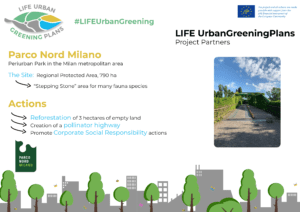
Parco Nord Milano in a nutshell
Parco Nord Milano is a Periurban Park in Milan. The total size is 790 hectares and the site includes urban forests, wet lands, lakes systems and meadows. The public body that manages the park was created to redevelop the suburbs north of Milan. Since 1975 it was recognized as a Regional Park by the Lombardy Region. Within the project they were responsible for Actions A2 and A9.
Barcelona Metropolitan Area
The Barcelona Metropolitan Area (AMB) is the public administration of the metropolitan area of Barcelona, which occupies 636 km² and encompasses 36 municipalities with more than 3.2 million inhabitants. The area of focus will be the Llobregat Riverside, which is a Mediterranean freshwater ecosystem. Within the project they were responsible for Actions A4 and A9.
Management Authority of Schinias Marathon National Park, Mount. Hymettus and Southeast Attica
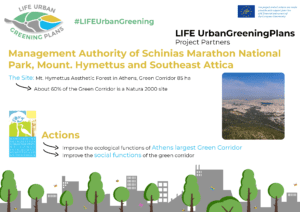
Management Authority of Schinias Marathon National Park, Mount. Hymettus and Southeast Attica in a nutshell
The management body of the National Park was established in 2003. The side, which is close to Athens, includes wetlands, coastal areas and pine forests. The main focus within the project was on the green corridor that spreads into Athens.
Philodassiki Enossi Athinon
Philodassiki Enossi Athinon is an NGO in Athens that is responsible for the creation of the Mt. Hymettus Aesthetic Forest. When it was established in 1899, it undertook the initiative of
the reforestation of the hills in and around Athens. Through the initiative of Philodassiki, the completely degraded hills in the center of Athens (Lycabettus, Philopappou, Ardittos, the Nymphs and Pnyka) were reforested at the same time with the barren of vegetation slopes of the Acropolis. Within the project it was responsible for actions A5 and A10.
You can find more details on the projects objectives and outputs here:

Objectives
LIFE UrbanGreeningPlans wants to enable local policy makers and green space managers of the 5 participating cities to design and demonstrate innovative mechanisms to increase the overall presence of biodiversity in their territories.
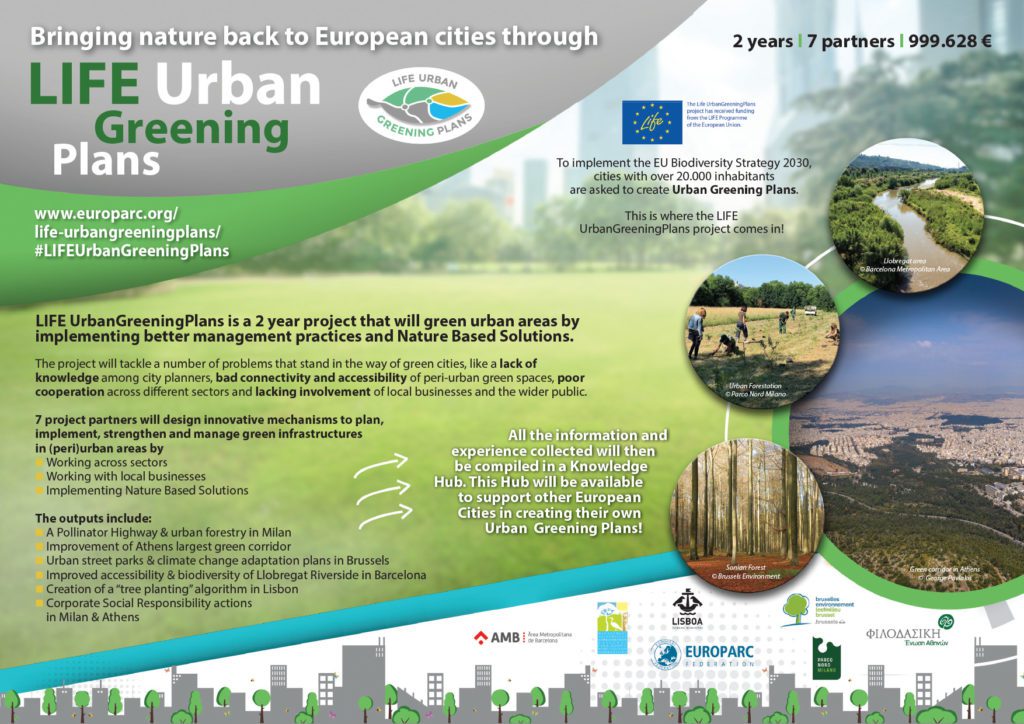
LIFE UrbanGreeningPlans in a nutshell
It aimed to do so by:
- Mobilizing international networks to identify the most promising mechanisms for biodiversity enhancement to be included in Urban Greening Plans
- Putting in place ambitious and promising management actions to increase and enhance biodiversity in 2 urban areas (Milan and Lisbon)
- Improve biodiversity, connectivity and accessibility in 3 peri-urban greenspaces, each of them with different casuistics (Athens, Barcelona, Brussels)
- Smoothen local decision-making and the implementation of innovative biodiversity mechanisms by actively involving different departments and/or different municipalities in co-decision processes and overcoming language barriers across sectors (Brussels, Barcelona)
- Develop mechanisms for local public authorities to involve businesses and the local public more effectively in implementing and managing (peri-)urban green spaces (Milan, Athens)
All the information and experiences collected laid the foundation for the Knowledge Hub, created specifically for local policy makers, green infrastructure planners en greenspace managers of other cities in Europe. Here they will find concrete examples and how-to guidelines to start their own Urban Greening Plans.
Finance
The total budget of the project was 999.628 € and is partially financed by the LIFE Programme of the European Union.
